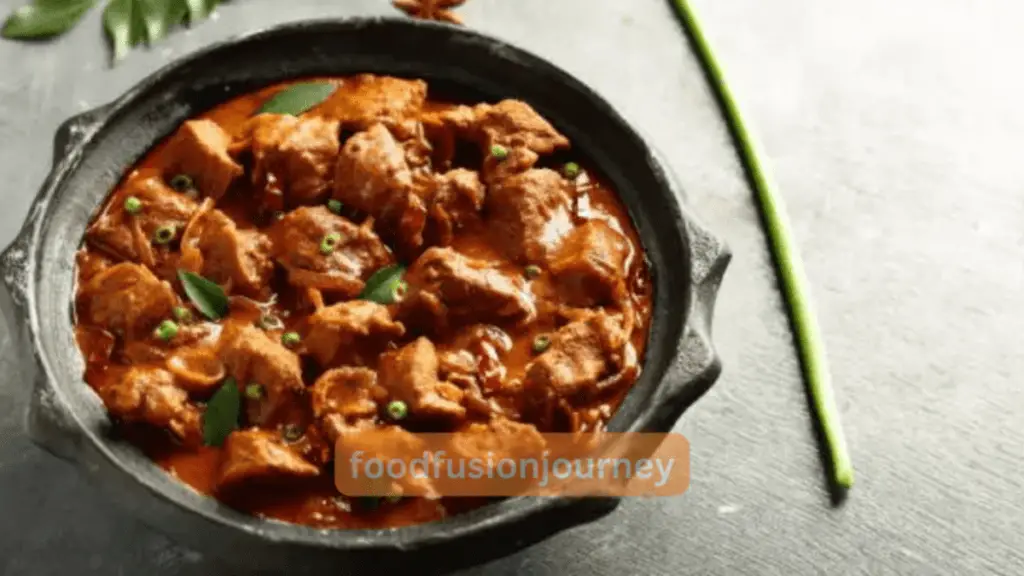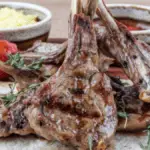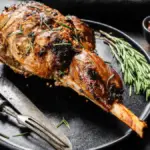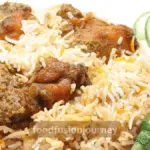Are you ready to tantalize your taste buds with our scrumptious mutton curry recipe. We’ll show you how to infuse tender mutton with aromatic spices creating a dish that’s a true flavor explosion. This is an Indian recipe.
Here’s a delicious recipe for mutton curry
Ingredients
For Marinating the Mutton
- 500 grams of mutton (bone-in pieces)
- 1 cup yogurt
- 1 tablespoon ginger-garlic paste
- 1 teaspoon turmeric powder
- 1 teaspoon red chili powder
- Salt to taste
For the Curry
- 3 tablespoons vegetable oil
- 2 onions, finely chopped
- 2 tomatoes, chopped
- 2 green chilies, slit
- 1 tablespoon ginger-garlic paste
- 1 teaspoon cumin seeds
- 1 teaspoon coriander powder
- 1/2 teaspoon garam masala
- 1/2 teaspoon cumin powder
- 1/2 teaspoon fennel seeds
- 1/2 teaspoon mustard seeds
- 1/2 teaspoon fenugreek seeds
- 2-3 cloves
- 2-3 green cardamom pods
- 1-inch cinnamon stick
- 1 bay leaf
- Salt to taste
- Fresh coriander leaves for garnish
Instructions
Marinate the Mutton
- In a large mixing bowl, combine the mutton pieces, yogurt, ginger-garlic paste, turmeric powder, red chili powder, and salt.
- Mix everything well to coat the mutton evenly.
- Cover and refrigerate for at least 2 hours, or overnight for best results.
Cooking the Mutton Curry Recipe
- Heat 2 tablespoons of vegetable oil in a heavy-bottomed pan or pressure cooker.
- Add the marinated mutton and cook on medium-high heat until it turns brown on all sides. This may take about 10-15 minutes.
Saute the Aromatics
- In another pan, heat the remaining 1 tablespoon of vegetable oil.
- Add the cumin seeds, mustard seeds, fennel seeds, fenugreek seeds, cloves, green cardamom pods, cinnamon stick, and bay leaf. Sauté until they release their aroma.
- Add the chopped onions and sauté until they become translucent.
Add Ginger Garlic Paste and Spices
- Add the ginger-garlic paste to the onions and cook for a couple of minutes until the raw smell disappears.
- Add coriander powder, cumin powder, and garam masala. Cook for another 2-3 minutes until the spices are well incorporated.
Tomatoes and Green Chilies
- Add the chopped tomatoes and green chilies to the onion-spice mixture. Cook until the tomatoes become soft and the oil starts to separate from the mixture.
- Combine Mutton with the Spice Mixture:
Add the browned mutton to the spice mixture. Stir well to combine everything.
Cooking the Mutton Curry
- Add enough water to cover the mutton pieces.
- Cover the pan or pressure cooker and cook on low heat until the mutton is tender. If using a pressure cooker, cook for about 4-5 whistles.
Check the Seasoning
- Once the mutton is tender and cooked through, check the seasoning and adjust the salt and spices according to your taste.
Garnish and Serving Mutton Curry Recipe
- Garnish the mutton curry with fresh coriander leaves.
- Serve hot with steamed rice or Indian bread like naan or roti.
- Enjoy your homemade mutton curry!
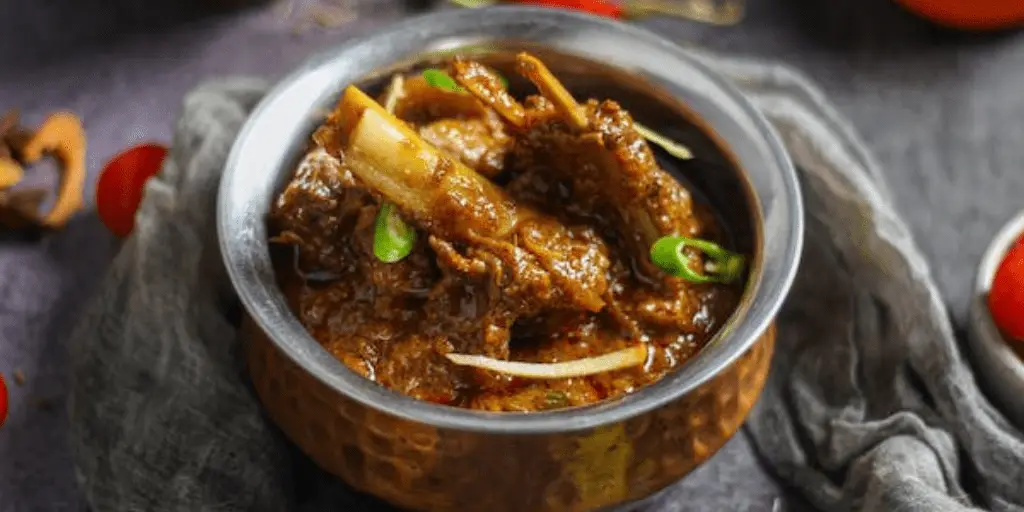
Some specific Tips and Tricks for Making A Delicious Mutton Curry Recipe
Meat Selection: Choose fresh mutton from a reliable source. Look for well-marbled cuts, as this will result in a more flavorful and tender curry.
Trim Excess Fat: While some fat is essential for flavor, trim any excessive fat from the mutton to prevent an overly greasy curry.
Marination: Marinate the mutton for a minimum of 2 hours, or overnight if possible. This helps in tenderizing the meat and infusing it with the marinade’s flavors.
Yogurt Thickness: Use thick yogurt for marination, as it clings better to the meat. Greek yogurt or hung yogurt works well.
Searing the Meat: When browning the mutton, ensure the pan is hot before adding the meat. Searing the meat seals in the juices and enhances the overall flavor.
Slow Cooking: Cook the curry on low heat for an extended period. Slow cooking allows the mutton to become tender and absorb the spices’ essence.
Layered Spices: Add spices in layers to build complexity. Start with whole spices (cumin seeds, cloves, cinnamon) in hot oil to release their aroma. Then add ground spices like coriander, cumin, and turmeric.
Onion-Tomato Base: Create a rich base by sautéing onions until golden brown and then adding tomatoes. Cook until the tomatoes break down and release their juices.
Balancing Heat: Adjust the amount of red chili powder and green chilies to suit your spice preference. Remember that some mutton cuts are naturally spicier.
Frequent Stirring: Stir the curry occasionally to prevent sticking or burning, especially during the slow-cooking process.
Stock or Water: Use hot water or mutton stock to maintain the desired consistency of the curry. Adding cold liquid can slow down the cooking process.
Lid or No Lid: If using a pressure cooker, follow the manufacturer’s instructions. In a regular pot, you can partially cover it with a lid, allowing some evaporation to thicken the curry.
Resting Period: Let the mutton curry sit for a few minutes after cooking. This allows the flavors to meld, making it even tastier when served.
Garnish Smartly: Garnish with fresh coriander leaves just before serving for a burst of freshness and color.
Storing and Reheating: Store any leftovers in the refrigerator, and when reheating, add a splash of water to maintain the consistency and prevent it from becoming too thick.
By following these tips and tricks you’ll master the art of making a delectable mutton curry recipe that’s sure to be a hit with your family and guests. Enjoy! Enjoy the taste of india, a flavourfull Delight.
Nutrition Facts

The nutrition facts for a Mutton Curry can vary depending on the specific recipe, portion size, and ingredients used. Here’s a general estimate of the nutrition content for a typical serving of Mutton Curry Recipe.
Serving Size: 1 serving (approximately 200-250 grams)
Calories in Mutton Curry Recipe
- Calories per serving: Approximately 300-400 calories
Macronutrients
- Protein: Approximately 20-30 grams
- Carbohydrates: Approximately 5-10 grams (varies based on recipe)
- Dietary Fiber: Approximately 1-2 grams
- Sugars: Approximately 1-3 grams
- Fat: Approximately 20-30 grams
- Saturated Fat: Approximately 6-10 grams
Vitamins and Minerals
- Sodium: Approximately 500-800 milligrams (varies based on seasoning)
- Potassium: Approximately 300-500 milligrams
- Calcium: Approximately 20-40 milligrams
- Iron: Approximately 2-4 milligrams
Please keep in mind that these values are approximate and can vary based on the specific recipe, ingredients, and cooking method. The nutrition content of Mutton Curry depends on factors such as the cut of meat used, the type and amount of oil or ghee used for cooking, and the spices and seasonings included in the recipe.
If you have a specific Mutton Curry recipe in mind or are using a particular product, it’s best to refer to the nutrition label if available or consult a registered dietitian for more precise information based on the exact ingredients and portion sizes used.
